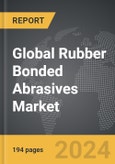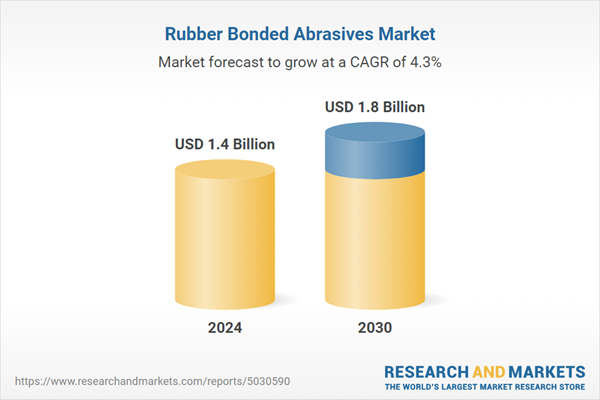The global market for Rubber Bonded Abrasives was valued at US$1.4 Billion in 2024 and is projected to reach US$1.8 Billion by 2030, growing at a CAGR of 4.3% from 2024 to 2030. This comprehensive report provides an in-depth analysis of market trends, drivers, and forecasts, helping you make informed business decisions. The report includes the most recent global tariff developments and how they impact the Rubber Bonded Abrasives market.
Segments: Application (Heavy Industries, Transportation Components, Electrical & Electronic Equipment, Medical Equipment, Other Applications).
Geographic Regions/Countries: World; United States; Canada; Japan; China; Europe (France; Germany; Italy; United Kingdom; Spain; Russia; and Rest of Europe); Asia-Pacific (Australia; India; South Korea; and Rest of Asia-Pacific); Latin America (Argentina; Brazil; Mexico; and Rest of Latin America); Middle East (Iran; Israel; Saudi Arabia; United Arab Emirates; and Rest of Middle East); and Africa.
The analysts continuously track trade developments worldwide, drawing insights from leading global economists and over 200 industry and policy institutions, including think tanks, trade organizations, and national economic advisory bodies. This intelligence is integrated into forecasting models to provide timely, data-driven analysis of emerging risks and opportunities.
Global Rubber Bonded Abrasives Market - Key Trends and Drivers Summarized
What Are Rubber Bonded Abrasives and Why Are They Vital for Industrial Applications?
Rubber Bonded Abrasives are grinding and finishing tools made from abrasive grains embedded in a rubber matrix, providing superior flexibility, resilience, and precision. These abrasives are widely used in various industrial applications, including metalworking, tool and die manufacturing, aerospace, automotive, electronics, and woodworking, where high-quality surface finishes, tight tolerances, and reduced chatter are required. Unlike traditional vitrified or resin-bonded abrasives, rubber bonded abrasives offer better control, smoother finishes, and minimal material removal, making them ideal for precision grinding, deburring, polishing, and honing operations. As industries continue to seek more efficient and precise finishing solutions, the demand for rubber bonded abrasives is increasing.How Are Technological Advancements Influencing the Rubber Bonded Abrasives Market?
Technological advancements are driving significant innovations in the design, formulation, and performance of rubber bonded abrasives, enhancing their effectiveness and application range. The development of advanced abrasive grains, such as cubic boron nitride (CBN) and diamond, is improving the cutting efficiency, durability, and thermal stability of rubber bonded abrasives, enabling them to handle tougher materials and higher temperatures. Innovations in rubber bonding materials and processing techniques, such as cryogenic and microwave curing, are enhancing the flexibility, resilience, and consistency of abrasives, providing better surface finishes and longer tool life. The integration of smart sensors, digital controls, and automated systems is enabling more precise and efficient grinding and finishing processes, reducing operator fatigue and minimizing waste. Additionally, the use of environmentally friendly bonding agents and recycled materials is aligning rubber bonded abrasives with sustainability goals and regulatory requirements.What Challenges and Opportunities Exist in the Rubber Bonded Abrasives Market?
The rubber bonded abrasives market faces several challenges, including high production costs, technical complexities in manufacturing, and competition from alternative abrasive technologies. The cost of high-quality abrasive grains, rubber compounds, and specialized manufacturing processes can be a barrier for some applications that require cost-effective solutions. Ensuring consistent quality, performance, and durability of rubber bonded abrasives, particularly in high-precision applications, can also be technically demanding. However, these challenges present substantial opportunities for growth and innovation. The increasing demand for precision grinding, polishing, and finishing solutions in industries such as automotive, aerospace, electronics, and metalworking is driving the need for advanced rubber bonded abrasives. The expansion of manufacturing activities, particularly in emerging markets, is further boosting the market potential. Moreover, the growing focus on automation, digitalization, and sustainable manufacturing is creating new opportunities for abrasive manufacturers to offer more innovative and high-performance solutions.What Factors Are Driving the Growth of the Rubber Bonded Abrasives Market?
The growth in the Rubber Bonded Abrasives market is driven by several factors, including the rising demand for precise, efficient, and high-quality grinding and finishing solutions across various industrial sectors. Technological advancements in abrasive grains, rubber bonding materials, digital controls, and automated systems are enhancing the performance, durability, and versatility of rubber bonded abrasives, driving their adoption. The increasing focus on reducing production costs, improving surface quality, and enhancing manufacturing efficiency is also contributing to market growth. Additionally, the expansion of the automotive, aerospace, electronics, and metalworking industries, particularly in emerging markets, and the growing trend towards automation and smart manufacturing are boosting the demand for advanced rubber bonded abrasives. The emphasis on sustainable manufacturing practices, reducing waste, and improving worker safety is further propelling the rubber bonded abrasives market forward.Report Scope
The report analyzes the Rubber Bonded Abrasives market, presented in terms of units. The analysis covers the key segments and geographic regions outlined below.Segments: Application (Heavy Industries, Transportation Components, Electrical & Electronic Equipment, Medical Equipment, Other Applications).
Geographic Regions/Countries: World; United States; Canada; Japan; China; Europe (France; Germany; Italy; United Kingdom; Spain; Russia; and Rest of Europe); Asia-Pacific (Australia; India; South Korea; and Rest of Asia-Pacific); Latin America (Argentina; Brazil; Mexico; and Rest of Latin America); Middle East (Iran; Israel; Saudi Arabia; United Arab Emirates; and Rest of Middle East); and Africa.
Key Insights:
- Market Growth: Understand the significant growth trajectory of the Heavy Industries segment, which is expected to reach US$664.0 Million by 2030 with a CAGR of a 5.2%. The Transportation Components segment is also set to grow at 4.3% CAGR over the analysis period.
- Regional Analysis: Gain insights into the U.S. market, valued at $361.6 Million in 2024, and China, forecasted to grow at an impressive 7.5% CAGR to reach $375.8 Million by 2030. Discover growth trends in other key regions, including Japan, Canada, Germany, and the Asia-Pacific.
Why You Should Buy This Report:
- Detailed Market Analysis: Access a thorough analysis of the Global Rubber Bonded Abrasives Market, covering all major geographic regions and market segments.
- Competitive Insights: Get an overview of the competitive landscape, including the market presence of major players across different geographies.
- Future Trends and Drivers: Understand the key trends and drivers shaping the future of the Global Rubber Bonded Abrasives Market.
- Actionable Insights: Benefit from actionable insights that can help you identify new revenue opportunities and make strategic business decisions.
Key Questions Answered:
- How is the Global Rubber Bonded Abrasives Market expected to evolve by 2030?
- What are the main drivers and restraints affecting the market?
- Which market segments will grow the most over the forecast period?
- How will market shares for different regions and segments change by 2030?
- Who are the leading players in the market, and what are their prospects?
Report Features:
- Comprehensive Market Data: Independent analysis of annual sales and market forecasts in US$ Million from 2024 to 2030.
- In-Depth Regional Analysis: Detailed insights into key markets, including the U.S., China, Japan, Canada, Europe, Asia-Pacific, Latin America, Middle East, and Africa.
- Company Profiles: Coverage of players such as Abrasivos Manhattan S.A., ATLANTIC GmbH Bonn, Atto Abrasives Ltd., Carborundum Universal Ltd., Hermes Schleifmittel GmbH and more.
- Complimentary Updates: Receive free report updates for one year to keep you informed of the latest market developments.
Some of the 42 companies featured in this Rubber Bonded Abrasives market report include:
- Abrasivos Manhattan S.A.
- ATLANTIC GmbH Bonn
- Atto Abrasives Ltd.
- Carborundum Universal Ltd.
- Hermes Schleifmittel GmbH
- Kerry Abrasives Ltd.
- Marrose Abrasives
- Pacer Industries, Inc.
- Pferd Inc.
- Redco
Tariff Impact Analysis: Key Insights for 2025
Global tariff negotiations across 180+ countries are reshaping supply chains, costs, and competitiveness. This report reflects the latest developments as of April 2025 and incorporates forward-looking insights into the market outlook.The analysts continuously track trade developments worldwide, drawing insights from leading global economists and over 200 industry and policy institutions, including think tanks, trade organizations, and national economic advisory bodies. This intelligence is integrated into forecasting models to provide timely, data-driven analysis of emerging risks and opportunities.
What’s Included in This Edition:
- Tariff-adjusted market forecasts by region and segment
- Analysis of cost and supply chain implications by sourcing and trade exposure
- Strategic insights into geographic shifts
Buyers receive a free July 2025 update with:
- Finalized tariff impacts and new trade agreement effects
- Updated projections reflecting global sourcing and cost shifts
- Expanded country-specific coverage across the industry
Table of Contents
I. METHODOLOGYII. EXECUTIVE SUMMARY2. FOCUS ON SELECT PLAYERSIII. MARKET ANALYSISSOUTH KOREAREST OF ASIA-PACIFICARGENTINABRAZILMEXICOREST OF LATIN AMERICAIRANISRAELSAUDI ARABIAUNITED ARAB EMIRATESREST OF MIDDLE EASTIV. COMPETITION
1. MARKET OVERVIEW
3. MARKET TRENDS & DRIVERS
4. GLOBAL MARKET PERSPECTIVE
UNITED STATES
CANADA
JAPAN
CHINA
EUROPE
FRANCE
GERMANY
ITALY
UNITED KINGDOM
SPAIN
RUSSIA
REST OF EUROPE
ASIA-PACIFIC
AUSTRALIA
INDIA
LATIN AMERICA
MIDDLE EAST
AFRICA
Companies Mentioned (Partial List)
A selection of companies mentioned in this report includes, but is not limited to:
- Abrasivos Manhattan S.A.
- ATLANTIC GmbH Bonn
- Atto Abrasives Ltd.
- Carborundum Universal Ltd.
- Hermes Schleifmittel GmbH
- Kerry Abrasives Ltd.
- Marrose Abrasives
- Pacer Industries, Inc.
- Pferd Inc.
- Redco
Table Information
| Report Attribute | Details |
|---|---|
| No. of Pages | 194 |
| Published | April 2025 |
| Forecast Period | 2024 - 2030 |
| Estimated Market Value ( USD | $ 1.4 Billion |
| Forecasted Market Value ( USD | $ 1.8 Billion |
| Compound Annual Growth Rate | 4.3% |
| Regions Covered | Global |









